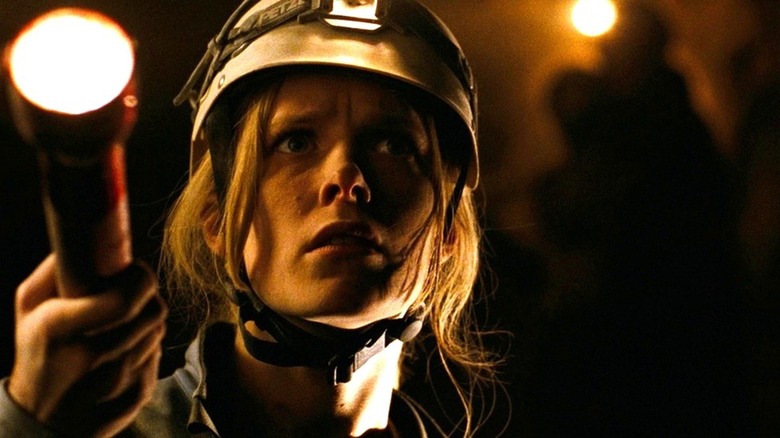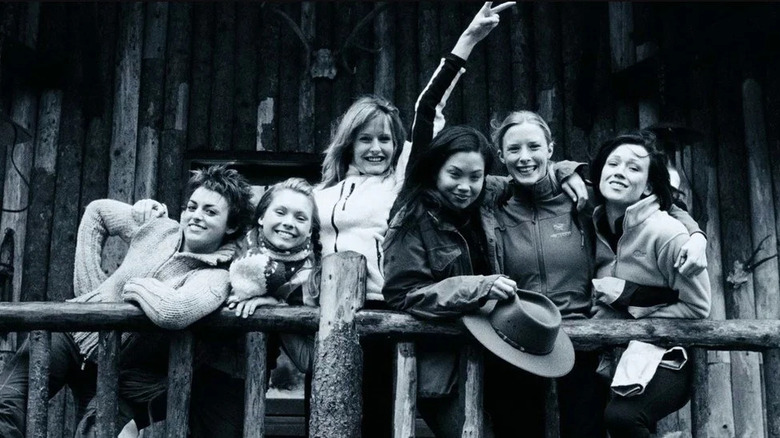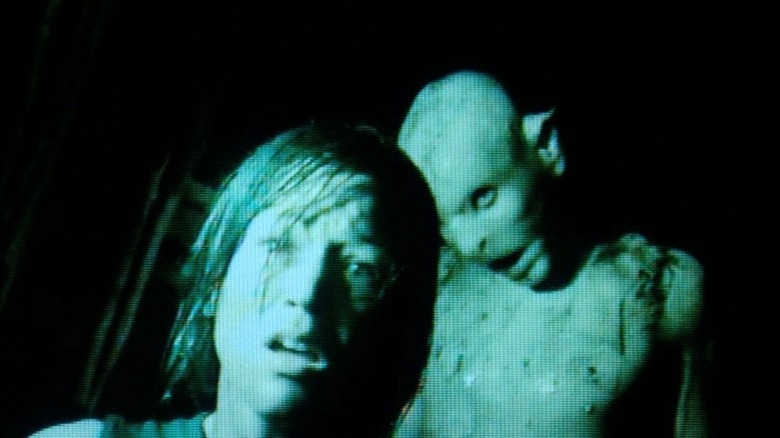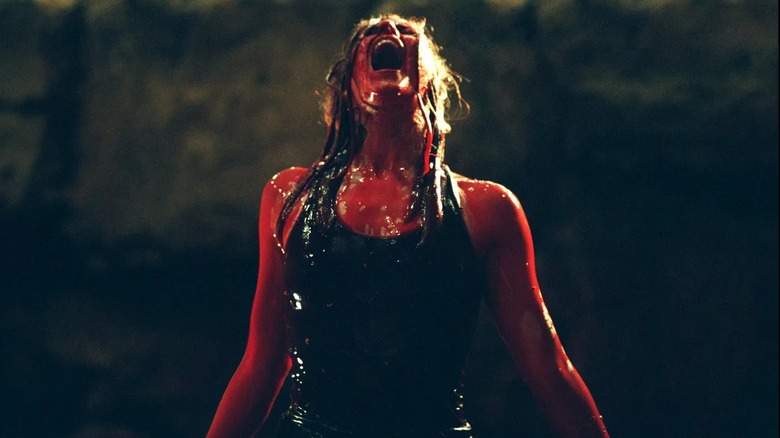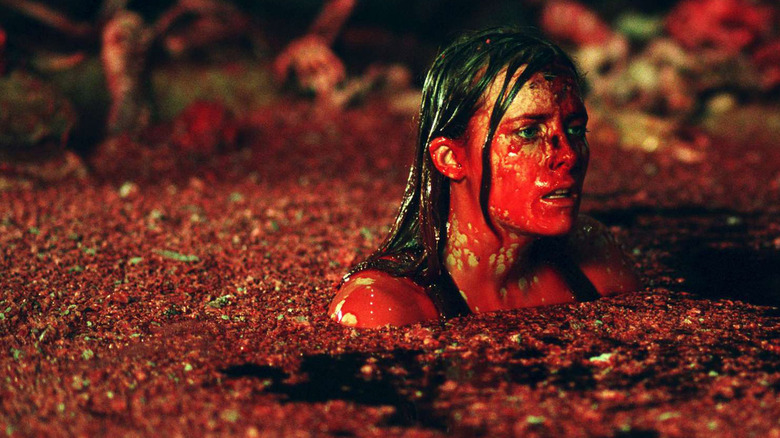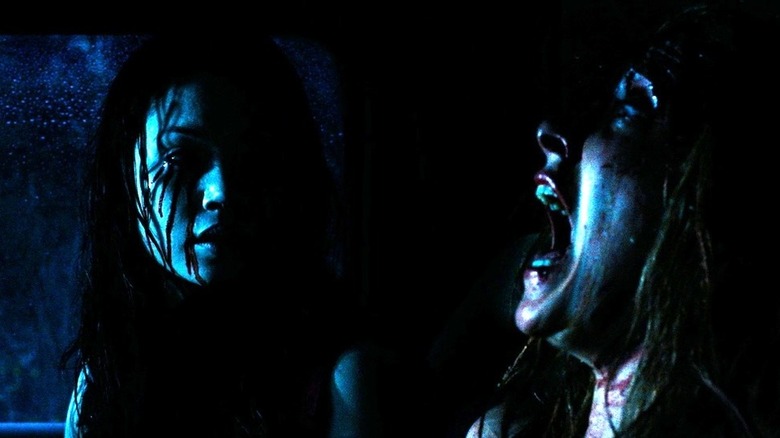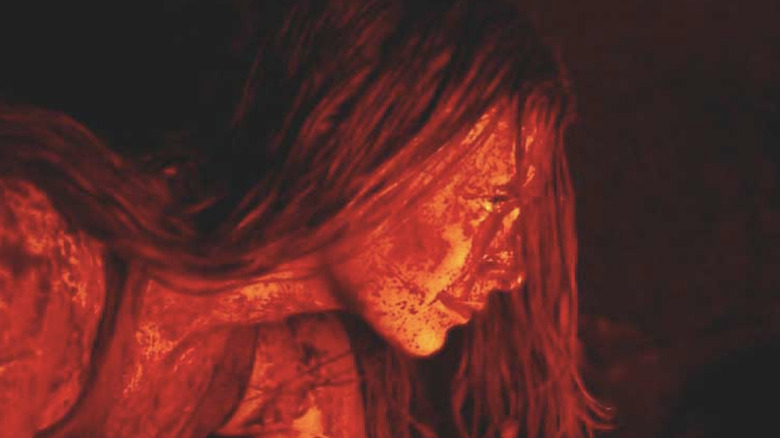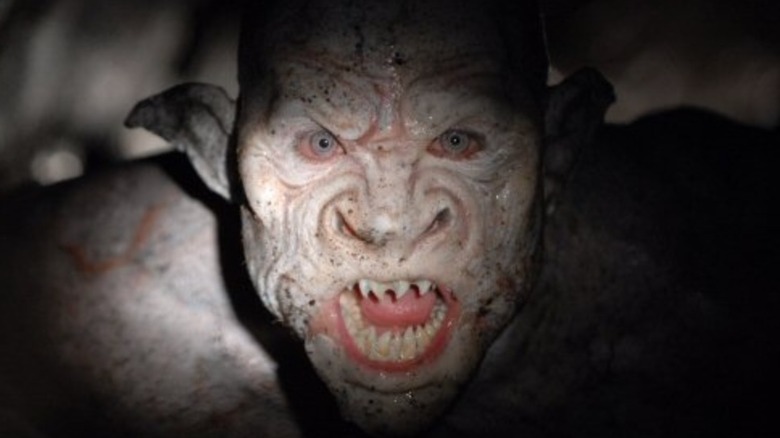The Descent Ending Explained: Can You Climb Out Of That Pit?
We may receive a commission on purchases made from links.
"Six women go spelunking" doesn't necessarily read as a great logline for a horror movie, but Neil Marshall's "The Descent" takes that premise and crafts an unforgettable exercise in terror. As the saying goes, it's a B-movie with A+ filmmaking.
Being trapped underground combines two common fears, confinement and darkness, and in "The Descent," the heavy shadows only reinforce the claustrophobia. Marshall and his cinematographer Sam McCurdy chose to light the film's sets (a facsimile of a real cave system built and shot at Pinewood Studios) primarily with the characters' flashlights. Even color choices — some frames are filtered entirely red or green — are used diegetically from those lights or flares.
As the characters get deeper and deeper into the cave, darkness subsumes each and every frame. It needs to, for the whole reason a cave is a scary setting is because of what you can't see. And yet, Marshall never loses track of his characters in the shadows, and if you're paying attention, neither will you. Where does this journey into hell end, though?
What you need to remember about the plot of The Descent
To understand how "The Descent" ends, we must start at the real inciting incident of the movie. Not our leads entering the cave, no. Sarah (Shauna Macdonald) loses her husband Paul (Oliver Milburn) and her daughter Jessica (Molly Kayll) in a car crash. Director Neil Marshall shoots a pipe crashing through the windshield from Jessica's POV, thus we see it impaling her father's face head from behind before it keeps barreling towards the camera, and us.
One year later, Sarah's estranged pal Juno (Natalie Mendoza) arranges the caving trip to bring their friend group of adrenaline junkies back together. Important addendum: Juno and Paul were having an affair, and this trip is Juno trying to face the combined guilt of that and abandoning Sarah while she was mourning.
Since this is a horror movie, the bonding of our leads — Sarah, Juno, Beth (Alex Reid), Rebecca (Saskia Mulder), Sam (MyAnna Buring), and Holly (Nora-Jane Noone) — is cut short by a cave-in. It turns out Juno brought them to an uncharted cave system, not the tourist trap they discussed, to spice up the adventure. As they dig deeper in hopes of finding an alternate exit, they discover why this cave remains undisturbed. It's home to some of cinema's scariest monsters — the "Crawlers," feral flesh-eaters who look like Nosferatu Neanderthals.
The group is splintered and picked off one by one, but Sarah and Juno become bonafide Crawler killers. Unfortunately, while fighting a Crawler, Juno accidentally strikes Beth with her pickaxe; a horrified Juno runs off, but not before Beth grabs her necklace (holding a pendant from Paul, inscribed with "Love Each Day.") Sarah then finds the dying Beth, who tells her not to trust Juno (sealing the deal by showing her the pendant) and asks for a mercy killing.
Juno and Sarah, the last two left, both see themselves as murderers.
What happens at the end of The Descent?
After fighting off another pack of Crawlers together, Sarah and Juno lock eyes in a standoff, the former holding her pickaxe up in her right hand. Sarah lets the pendant fall, revealing to Juno that she's aware of her sins, then impales Juno's leg with the axe and runs off. Juno pulls the axe out of her leg and prepares for a last stand. The camera pulls out to show about a dozen Crawlers advancing on her, then cuts away to Sarah, who hears Juno's screams.
Sarah trips and falls down a shaft, but when she comes to, daylight shines on her face. She climbs out of the cavern and reaches the surface. Still hysterical, she runs back to the car that she and the others came in and drives off, making it back to a public road and pulling over. Taking a moment to cry and vomit, she spots a ghostly Juno sitting in the passenger seat and screams.
Then, in the film's original U.K. ending, she awakens, still in the cave. Her escape was just a dream, so she retreats into another one — seeing Jessica and sharing a candlelit cake for the birthday her daughter never got to have. The camera pulls back to reveal Jessica isn't there and Sarah is staring at nothing (the cake's candles are really the flame of her torch). As the shot gets wider, it's clear Sarah is nowhere near the surface and the Crawlers' shrieks are getting closer.
The film goes to the credits, initially played over the group photo the characters took, now no longer a memento but instead a final marker of their fate.
What the end of The Descent means
The "it's all just a dream" ending feels like a sucker punch, but it's really part of a pattern. When Sarah awakens at the hospital in the film's opening, she imagines it's empty and starts running down the hall until Beth grabs her and snaps her back to reality (a heavy green filter gives way to more naturalistic colors to signify the shift). Sarah was trying to run away from the tragedy that befell her.
At the cabin, Sarah has another jump scare dream when she imagines a pipe crashing through a window and crushing her face. She also imagines Jessica three prior times throughout the movie (the first two have the birthday cake motif, while the third has a jump scare where Jessica turns around and reveals a Crawler's face).
It should also be remembered that the title of "The Descent" has many meanings. As Neil Marshall has explained, "What it is about is descent into madness and physical descent into the depths of the Earth." When Sarah falls into a pool of blood left over from the Crawlers' victims, it's like her baptism into insanity. As for her leaving Juno behind, there might be a pragmatic reason (leave her to distract the Crawlers so Sarah can escape), but she also just wants her to suffer.
This physical and mental descent is what makes the ending such a cruel twist. There's a wide shot of Sarah crawling up the tunnel of darkness towards a light shining at the end. This ascent is not just her getting out of the cave, but potentially the pit she's been in for a year. In the end, however, getting over her pain was a fantasy. All she has is her daughter's memory, so she'll cling to it in the brief time she has left, resulting in one of the most haunting horror movies ever made about grief.
Was the ending of The Descent all in Sarah's head?
Since the movie is about Sarah's descent into madness, a common fan theory is that she imagined much more than just her daughter and her escape. This theory suggests the Crawlers were never real and it was the increasingly violent Sarah who murdered all of the others.
At the cabin, before the group leaves, Sarah is taking medication of some sort. Her falling off her meds and suffering a hallucination in the caves could make some sense. Likewise, when Sarah first spots a Crawler, the others say it's her mind playing tricks on her. And of course, Sarah proves throughout the movie she isn't in stable condition and, when pushed, can be violent.
However, this theory has never really held up for me; "The Descent" is simply too objective a movie that even a shared hallucination doesn't quite work with what's shown onscreen. For instance, the other characters see Crawlers when Sarah is not around. A pair of them kills Holly and then Juno fights them off to protect her body (leading to the tragic accident with Beth). Rebecca and Sam are shown alone in several scenes trying to evade the Crawlers. When Juno comes to their rescue and kills one (Sam spitting on its corpse), she insists they find Sarah. How does Sarah as the killer square with scenes where the characters are fighting off more than one Crawler, too?
Plus, the caves include physical signs of the Crawlers, their past victims, and previous explorers; the Crawlers have a bloody nest filled with human and animal corpses, while the leads also come across rusty climbing gear and cave paintings.
Sarah as the real killer is one of those ending theories that only sounds clever if you don't think about it too deeply.
What have the cast and crew of The Descent said about the ending?
Neil Marshall offered extensive thoughts on the ending in a 2021 interview with Vulture, both on his creative process and the in-text meanings. For instance, he confirmed that in the original ending, Sarah is doomed. "She's either going to starve to death or fall off a cliff or get attacked by a crawler. But she's with her daughter. That's what mattered most to her."
Shauna Macdonald gave her interpretation in a 2005 interview with eatmybrains.com:
"I think it's great to say to the audience, 'Actually, now you have to make up your own minds. We've told the story, now you decide for yourself what happens.' But the way it was in the script was like, 'There's no way out.' That's how I interpreted it when I read it, but when you see it there's more than [one] way to interpret it."
Describing Sarah's choice to kill Juno instead of confronting her, Marshall told Vulture:
"The characters don't have an opportunity to sit down and have a chat about [Juno's actions]. [... Sarah's] like, 'Once I see her again, it's not time for words.' It was show don't tell. Showing her the necklace meant she knew about the husband and about Beth. It was like, 'Ah, okay.'"
In the same interview, Marshall says the Crawlers are "cavemen who stayed in the cave [...] they've evolved to live there instead of in houses, like the rest of us." This fits with the cave paintings and the Crawlers hunting by sound (they've evolved past sight since they live in the dark). He added that while he wrote the film with the mindset that the Crawlers were real, he and his team "interjected all of these teasers and hidden meanings" during editing to suggest the "Sarah is imagining things" interpretation.
Sarah escapes the cave in the American ending of The Descent
After its initial run in the U.K. in 2005, "The Descent" was picked up for U.S. distribution the following year by Lionsgate. They asked Marshall for a different ending; while he didn't agree that American audiences needed a softer ending, he agreed in exchange for a 3,000 theater-wide release.
One of horror's most controversial final moments, the U.S. cut of "The Descent" ends on the shot of Sarah seeing Juno in the car and screaming, without the scene of Sarah awakening in the cave. In this version, she does escape, at least in the most literal sense.
Now let's dig into Juno appearing in the car. In the U.K. ending, it's a sign that this whole sequence is a dream, but what about the U.S. ending? No, she didn't somehow escape the Crawlers to take revenge on Sarah, nor is it a literal ghost. Rather, the shot represents how Sarah will continue to be traumatized by what's happened to her and what she did. Even if Sarah makes it back to the surface, Juno will be "haunting" her metaphorically.
Even though I prefer the original ending, this alternate version isn't a total desecration of the movie's themes and intent. There's the same sucker punch where Sarah seems to make it back to the light of day, only for the reality of her situation to kick in. Marshall concurs, telling Vulture, "It was literally, they clipped 30 seconds off the end. It makes a difference, but it wasn't rewriting the whole movie. So I could live with it."
Which ending of The Descent is darker?
In the aforementioned Vulture interview, Neil Marshall said he actually considers the U.S. ending to be the bleaker of the two. The U.K. ending is happier, "Not for us, but for her [...] She loses her mind, but she finds her daughter. That brings her a degree of happiness, which she's not gonna get if she escapes from the cave." In the U.S. ending, on the other hand, "She survives, but she's clearly out of her mind with fear and madness. So I don't see it as being a happy ending at all, having her get out of the cave."
Indeed, take note of Sarah's reactions in the different endings. In the original, she looks satisfied (Marshall directed Macdonald to show, "A glint — not of a smile, but of happiness in her eye that she was with her daughter again"). In the U.S. cut, the film ends with her screaming.
The two endings of "The Descent" have only increased discussion about the movie and its fame, which for Marshall is a win:
"It does seem to be quite a conversation point. But at the end of the day, people are talking about the movie still, which isn't a bad thing. If people want to analyze the endings, that just adds to the overall analysis of the movie, and I welcome that. I love it. I think it's fascinating: 'Which one's the bleak ending, which one's not?'"
What the ending of The Descent means for the franchise
"The Descent" was a success (becoming one of the best horror movies ever made and bringing in $57 million at the box office), so distributor Pathé made a sequel over Marshall's objections. "The Descent Part 2," directed by the first film's editor Jon Harris, was released in 2009. By necessity, it carries on from the U.S. ending because Sarah (Shauna Macdonald again) has escaped the cave. During the film, the now amnesiac Sarah and a rescue team have to go back in to find her friends, where they meet the Crawlers and the somehow still alive Juno.
Speaking to SciFiNow in 2009, Macdonald said that if there were to be a "The Descent Part 3," then she "would like to see the story continued above ground." However, the sequel turned out quite middling, and no such film ever emerged.
Neil Marshall was quite candid about his dislike for "The Descent Part 2" to Vulture, saying, "I originally tried to guide it a bit, but most of my advice was ignored, so I was like, forget it." His pitch was that Sarah would go back into the caves to rescue a child abducted by the Crawlers, a more compelling motivation than amnesia for sure.
However, Marshall doesn't think the sequel "take[s] away from the first movie." I for one can testify that whenever I watch "The Descent," my thought isn't, "I want to see what happens next." Why disrupt a knockout punch of an ending by asking for more?
